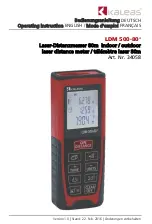
6
Chapter 1
Introducing the Nor118
7
Norsonic Nor118
User Guide
the instantaneous , the maximum and the minimum
, the equivalent level, the sound exposure level and
the maximum peak level. All levels are measured as -
weighted and - or -weighted levels.
e time profile logs the -weighted equivalent level,
the -weighted maximum sound pressure level and the
- or -weighted peak level.
The enhanced profile option.
In need of even better
resolution or better control of the functions measured?
No problem! e time profile extension can be expanded
into the enhanced profile extension – our option for the
Nor118. Order it when you purchase your Nor118 or later,
if that suits you better.
In the enhanced mode, the instrument logs the time
profile of the same functions as with the global:
• e Instantaneous Sound Pressure Level
•
MAX
e Maximum Sound Pressure Level
•
MIN
e Minimum Sound Pressure Level
•
eq
e Integrated Equivalent SPL
•
E
e Sound Exposure Level
•
PEAK
e Maximum Peak Level
If you then add the option , parallel time constants, you
may set up the instrument to log any combination of
functions and time constants, for example the with
time constant and the maximum with time constant
simultaneously.
Enhanced time resolution as well
. e enhanced pro-
file has a time resolution which can be from 100 ms and
upwards in 25 ms steps (in 1 second steps above 1 second
time resolution), so beware unless you want to create a busy
day for yourself – there will easily be quite a lot of data
generated, so avoid more details than strictly needed!
Multispectral measurements
e Nor118 functionality can be expanded to include
multispectral measurements. is extension takes the
instrument’s time profile capabilities to new heights by
allowing complete spectra to be logged as a function of
time.
Source coding
Have you ever made a measurement where you later found
out that you desperately need to know what caused the
level to be what it turned out to be?
Enter
source coding
. With the enhanced profile option
you may tag or code sources as they happen. A one digit
code (which appears in the display as 1~4) is entered to
later serve as an identification of the type of noise. is
can also be referred to as adding a marker to the meas-
urement.
For example, in a traffic noise measurement a bus pass-
ing may be identified by the digit “1”, while trucks may be
identified by “2”, unexpected vehicles by “3” etc. In the
profile display the markers appear as dots or lines below
the graph. If you move the time cursor onto such a dot, the
marker type (i.e. its number) will appear in the display.
During a measurement, adding any of the markers 1,
2 and 3 will assign the corresponding marker number to
the current period only. Adding marker number 4, how-
ever, will assign this marker to the current period plus all
Содержание nor118
Страница 2: ......
Страница 3: ...nor118 REAL TIME ANALYSER ...
Страница 13: ...nor118 REAL TIME ANALYSER ...
Страница 114: ......
Страница 115: ......
















































